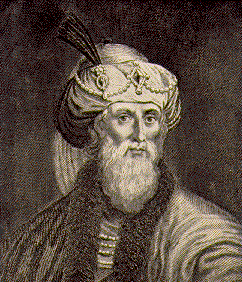The historical evidence for Christ
Posted: Sun Mar 07, 2010 1:27 pm
I'm creating a post for some historical evidence for Christ (for his literal existence and the claims of the Bible). I'm intentionally putting this in the science section because I think we are going to hit on some science here and there. Also please note, some of this material will be taken from other sections of this forum.
To start with Christ's history, I think it is important to focus on sources outside of the Bible for authenticity.. Of course we could go into the Bible and find a lot of evidence, i.e. Christ showing himself to over 500 witnesses (1 Corinthians 15: 5-8), or firstly women (Luke 24:10, a weak source in those days) after the resurrection, but others are from the following sources...
1. Cornelius Tacitus (AD 55-120). A Roman historian that recorded references to Christ. The most important one is that found in the Annals, which also mentions Pontius Pilate as Christ's persecutor.

2. Josephus Flavius (37-100 AD). A Jewish-Roman historian who wrote various passages about Christ. His supposed sorcery, his death and resurrection, and his brother James and John the Baptist.
3. Gaius Suetonius Tranquillas (AD 117-138). Another Roman historian that recorded references to Christ. Recorded the riots which broke between the Jews and Romans in the year AD 49 during the investigation of Christ claims.
4. Thallus (AD 52). Historian that references a darkness and earthquake that occurred during Christ's crucifixion, referenced by Julius Africanus.
5. Pliny the Younger (AD 61—112). Roman author that mentions the spread of early Christianity to pagan temples and includes early Christian practices.
6. Emperor Trajan (AD 53-117). Gave some of the first Roman views about early Christianity and corrective actions towards Christians.
7. Emperor Hadrian (AD 117-138). Early judgments towards Christians.
8. The Talmud, Sanhedrin 43a (AD 70-200). Explicitly states that Jesus was killed on the eve of the Jewish Passover. 40 days prior he was going to be stoned for sorcery but was later hung (presumably on the cross).
9. Toledoth Jesu (2nd Century?). Anti-Christian document that records what happened to Christ's body after his death.
10. Lucian (2 Century). Greek satirist who recorded the early practices and facts of the Christians.
11. Mara Bar-Serapion (1st and 3rd Century). Ancient manuscript that records Christ as a wise “king” of the Jews.
12. Gnostic sources:
a. The Gospel of Truth (AD 135-160)
b. The Apocryphon of John (AD 120-130)
c. The Gospel of Thomas (AD 140-200)
d. The Treatise On Resurrection (2nd Century)
e. The Gospel of the Nazaraeans (AD 150?)
f. The Gospel of Judas (180 AD)
g. The Gospel of Mary (120—180 AD)
13. Lost Works:
a. Acts of Pontius Pilate (AD 150).
b. Phlegon (AD 80).
Early Christian Writings a good source for early Christian works. Please note that the Early Church Fathers between 100 and 200 AD referenced the four Gospels and other earlier Christian books in their books. Therefore the Gospels must have been written before their claims..
If anyone wants to add to the list, please post it, I know there is much more..
To start with Christ's history, I think it is important to focus on sources outside of the Bible for authenticity.. Of course we could go into the Bible and find a lot of evidence, i.e. Christ showing himself to over 500 witnesses (1 Corinthians 15: 5-8), or firstly women (Luke 24:10, a weak source in those days) after the resurrection, but others are from the following sources...
1. Cornelius Tacitus (AD 55-120). A Roman historian that recorded references to Christ. The most important one is that found in the Annals, which also mentions Pontius Pilate as Christ's persecutor.

2. Josephus Flavius (37-100 AD). A Jewish-Roman historian who wrote various passages about Christ. His supposed sorcery, his death and resurrection, and his brother James and John the Baptist.
3. Gaius Suetonius Tranquillas (AD 117-138). Another Roman historian that recorded references to Christ. Recorded the riots which broke between the Jews and Romans in the year AD 49 during the investigation of Christ claims.
4. Thallus (AD 52). Historian that references a darkness and earthquake that occurred during Christ's crucifixion, referenced by Julius Africanus.
5. Pliny the Younger (AD 61—112). Roman author that mentions the spread of early Christianity to pagan temples and includes early Christian practices.
6. Emperor Trajan (AD 53-117). Gave some of the first Roman views about early Christianity and corrective actions towards Christians.
7. Emperor Hadrian (AD 117-138). Early judgments towards Christians.
8. The Talmud, Sanhedrin 43a (AD 70-200). Explicitly states that Jesus was killed on the eve of the Jewish Passover. 40 days prior he was going to be stoned for sorcery but was later hung (presumably on the cross).
9. Toledoth Jesu (2nd Century?). Anti-Christian document that records what happened to Christ's body after his death.
10. Lucian (2 Century). Greek satirist who recorded the early practices and facts of the Christians.
11. Mara Bar-Serapion (1st and 3rd Century). Ancient manuscript that records Christ as a wise “king” of the Jews.
12. Gnostic sources:
a. The Gospel of Truth (AD 135-160)
b. The Apocryphon of John (AD 120-130)
c. The Gospel of Thomas (AD 140-200)
d. The Treatise On Resurrection (2nd Century)
e. The Gospel of the Nazaraeans (AD 150?)
f. The Gospel of Judas (180 AD)
g. The Gospel of Mary (120—180 AD)
13. Lost Works:
a. Acts of Pontius Pilate (AD 150).
b. Phlegon (AD 80).
Early Christian Writings a good source for early Christian works. Please note that the Early Church Fathers between 100 and 200 AD referenced the four Gospels and other earlier Christian books in their books. Therefore the Gospels must have been written before their claims..
If anyone wants to add to the list, please post it, I know there is much more..











